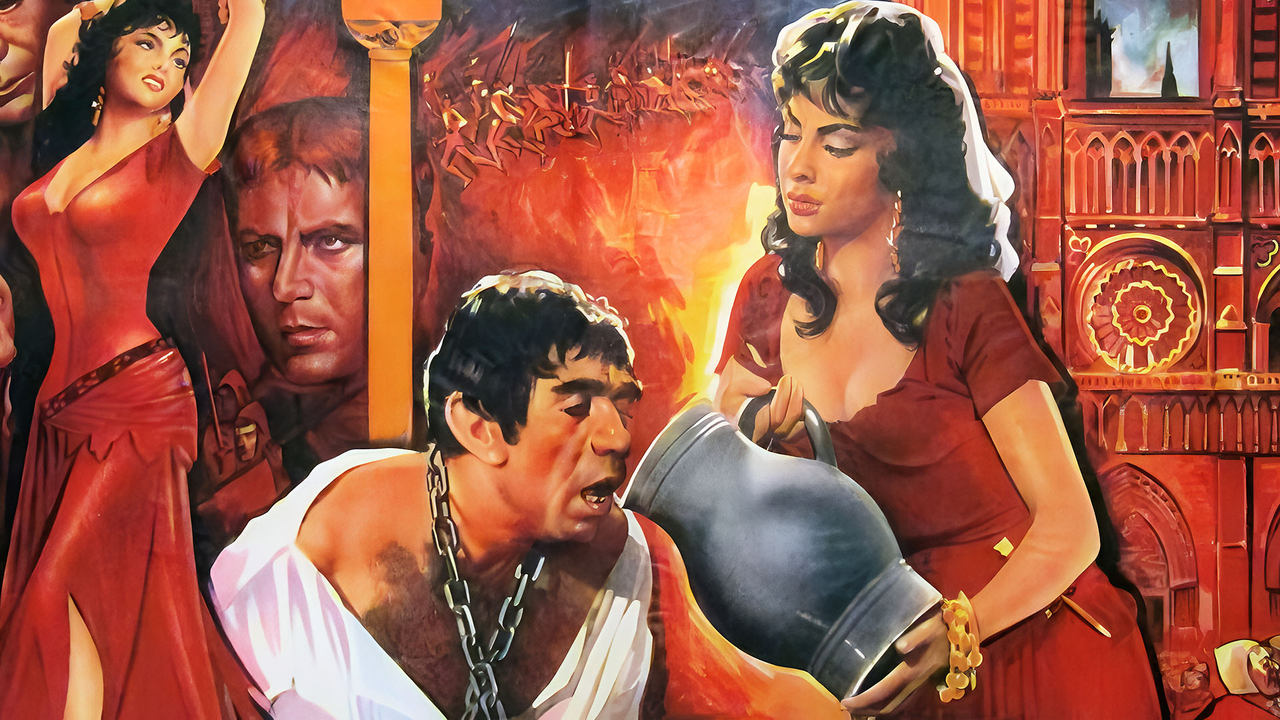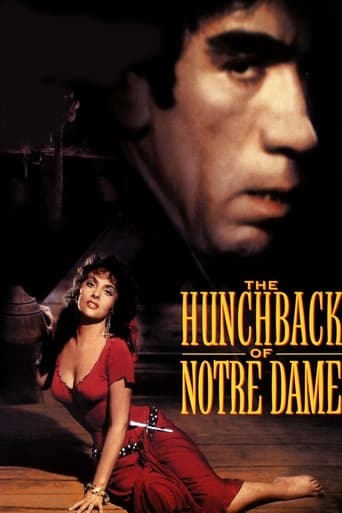

Good story, Not enough for a whole film
... View MoreInstead, you get a movie that's enjoyable enough, but leaves you feeling like it could have been much, much more.
... View MoreThis movie was so-so. It had it's moments, but wasn't the greatest.
... View MoreThe movie's neither hopeful in contrived ways, nor hopeless in different contrived ways. Somehow it manages to be wonderful
... View MoreThis is a movie that has all the trappings of an epic, but isn't. But it is still a credible rendition of the Victor Hugo classic, with Gina Lollobrigida giving a strong performance as Esmeralda. The weak part of the movie is Anthony Quinn's performance as Quasimodo. Mr. Quinn's portrayal is not believable. Quasimodo is supposed to generate feelings of pathos; that does not happen in this movie. As a result, the plot becomes flat. The intensity of the relationship between Quasimodo and Esmeralda is lacking. Between Mr. Quinn's mumbling of his lines, and the treatment of the poet Gringoire as a buffoon, the movie teeters on the brink of cinematic collapse. Yet, it is saved by staying faithful to the original story and by good performances by some of the supporting cast, as well as by the essential power of the original story. The story of the hunchback and the gypsy girl is classic; read the book.
... View MoreThe Hunchback of Notre Dame is a very hard film to make. Mostly due to the darkness and despair of the original work. If you've only grown up with the Disney version, prepare to be shocked. I truly liked this effort, as it got a lot of the complexities of each character down. Frollo is a man of religion but also science. His faith and logical mind battling it out as he experiences lust. Esmerelda is a victim of her own beauty, but also plays a hand in her own downfall. She doesn't understand her power over men which leads to her angering of the males. Quasimodo is portrayed as not so much an outcast here. He is known by all, but is awkward and unaware of his strength. This is a film where everyone is guilty for their actions, which also makes them all sympathetic. The design of the film is often too much. WIth so many colors and such production put in it comes across as an over the top school production. Less can be more, but with the final heart wrenching scene, you'll probably be left as an emotional wreck.
... View MoreFirst color version of Victor Hugo's novel is indeed colorful, well-done historical spectacle, with Gina Lollobrigida as mature, pure, red-dressed Esmeralda - it is indeed easy to see the men fall for her - and Anthony Quinn as sympathetic Quasimodo. However, it is Alan Cuny who steals the show as hissable but tortured Frollo. He is very good, as well as too handsome in the role of prematurely aged, balding man. Unfortunately scripts cuts away the important scene where Frollo goes to the Esmeralda's death-cell, confesses his love, shows the marks of self-punishment - which he made when Esmeralda was tortured - and tries to drag the girl to safety. One of the highlights of the book - and they cut it! Still, an underrated movie.
... View MoreDepending on how you look at it this is either the best "Hunchback" or the worst; for my money Lon Chaney will always be the Quasimodo for me but before I discount this version too much, I'll review its good points.1) It does remain faithful to Hugo's novel; 2) We get to see Quasimodo in color.Now the bad points:1) Quinn acts as though he'd rather be anywhere than making this movie; 2) The dubbing is terrible in some spots; 3) Quasimodo doesn't appear to be hunchbacked; 4) Esmeralda is more sex pot than innocent 16 year old; 5) The musical score leave a lot to be desired.You've got to wonder about Quinn's patience in the make-up chair. His incarnation of Quasimodo isn't really that ugly and does not even come close to the description given by Hugo in his novel. In fact, Lon Chaney and Anthony Hopkins are the only actors that came close to Hugo's description. I kinda thought Quinn's incarnation of Quasimodo resembled a punch drunk boxer --- his Quasimodo just appeared dumb. Beyond Quasimodo and Esmeralda the other characters just never developed.This movie could have been good but everyone from the director to the producers to the actors dropped the ball. Watch this one if it comes on TV but save your money for the Laughton, Chaney or Hopkins version.Here's how I rank the versions of the "Hunchback"1. Chaney (The Master!) 2. Hopkins (Make-up job superb - just like Hugo described him!) 3. Laughton (Brilliant acting job - most powerful flogging scene.) 4. Quinn (It's in color.) 5. Patinkin (This ranking is not necessarily a knock on Patinkin's Quasimodo, it's a knock on the production & writing which does not follow Hugo's novel at all; the sequence of events is all out of order.) 6. Clarke (A BBC Turkey. Shot on video tape with a lower than low budget. I got the feeling I was watching some drama students put on a play their friend recorded.)
... View More